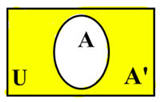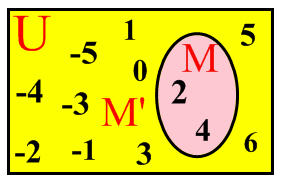 |
|||||||||||||||||||||
|
|
Complement of a SetIn this lesson we will learn how to find the complement of a set.
Vocabulary used in this lesson:
Definition: The complement of a set is the set of all elements in the universal set that are not in the initial set. Example: The complement of the set A in the above picture is set A' indicated in yellow. Tips:
The intersection between a set and its complement is the null set. Example: If the universal set U = {x: x integer; -6< x <7 } and M = {y: y even number; 1< y <5}, what is the complement of M? Solution: First, let's find all elements of sets U and M. U = {-5, -4, -3, -2, -1, 0, 1, 2, 3, 4, 5, 6}; M = {2, 4} We can also draw a Venn diagram to display sets U, M, and M'.
The complement of set M is a the set highlighted in yellow, whose elements are in set U, but not in set M. Therefore M' = {-5, -4, -3, -2, -1, 0, 1, 3, 5, 6}. Return from the Complement of a Set page to Data & Probability Lessons.
|
|
|||||||||||||||||||
Copyright
© 2008-2009
Doina Popovici |

 The
The